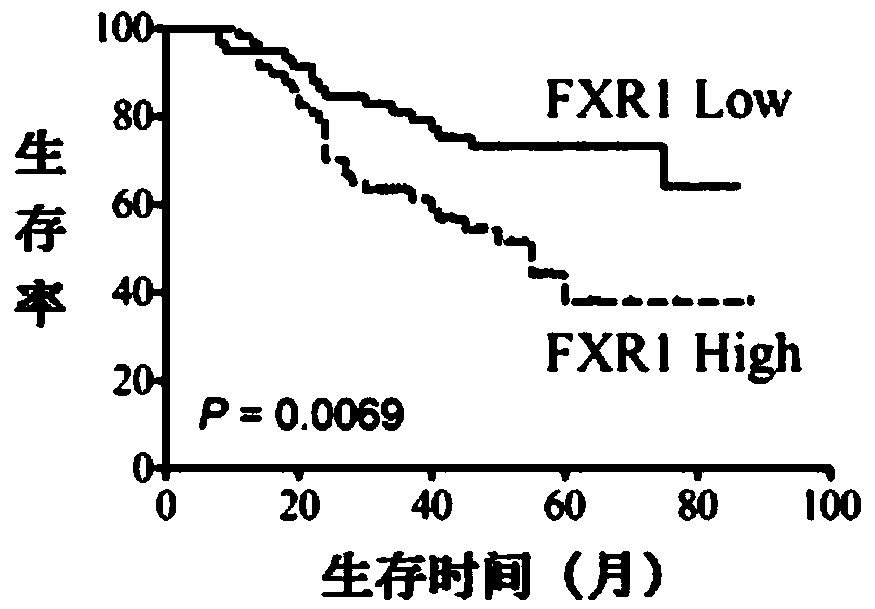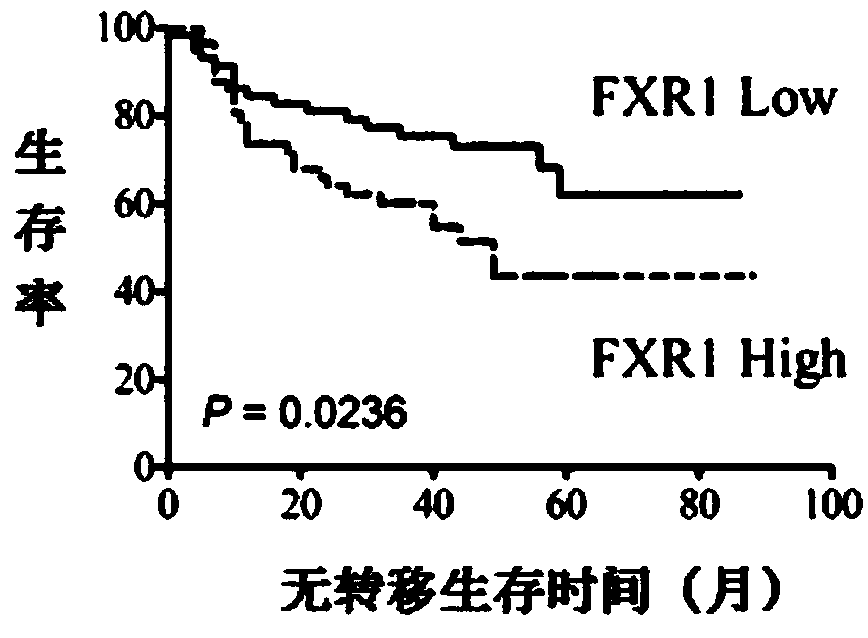A molecular marker for esophageal cancer and uses thereof
A molecular marker, esophageal cancer technology, applied in the field of tumor molecular biology, can solve the problems of unacceptable, easy to miss diagnosis, and suffering for patients, so as to improve the effect of cancer treatment, improve the quality of life, and assist clinical treatment.
- Summary
- Abstract
- Description
- Claims
- Application Information
AI Technical Summary
Problems solved by technology
Method used
Image
Examples
Embodiment 1
[0060] This embodiment provides a method for detecting the expression level of FXR1 gene in esophageal cancer tissue (Tumor) and paracancerous tissue (Normal), specifically comprising the following steps:
[0061] 1. Sample collection
[0062] Esophageal cancer tissues and adjacent normal tissues of esophageal cancer were collected from 115 patients with esophageal cancer. All tissue samples were from first-time patients, and were diagnosed as esophageal squamous cell carcinoma by pathologists. Esophageal cancer tissue and adjacent normal tissue specimens were obtained from the tumor resource bank of Sun Yat-sen University Cancer Center. Fresh specimens were quick-frozen in liquid nitrogen and then stored in a -80-degree refrigerator.
[0063] 2. Extract tissue RNA
[0064] (1) Take 50 mg of tumor tissue and 50 mg of normal tissue adjacent to the tumor, wash them with PBS (pH 7.4), add 1 ml Trizol, transfer to a 1.5 ml EP tube, mix well, and let stand for 5 minutes;
[0065]...
Embodiment 2
[0090] This embodiment provides a method for statistical analysis of the clinical characteristics of patients with esophageal cancer, specifically including the following:
[0091] 1. Sample information collection
[0092] Taking 115 patients diagnosed with esophageal squamous cell carcinoma in Example 1 as the experimental subjects, the hospitalization time of the patients was between 2004 and 2007, the age range was from 34 to 80 years old, and the average age was 56 years old. The clinical data and follow-up data of the patients come from the patient's inpatient medical records, outpatient follow-up records and telephone follow-up records. The gender, age, tumor location, local invasion (T stage), lymph node metastasis (N stage), distant metastasis (M stage) and pathological grade information of 115 patients were collected.
[0093] 2. SPSS 16.0 software (SPSS Inc, Chicago, IL, USA) was used for data statistics and analysis. P Figure 2A and Figure 2B ); Cox regression m...
Embodiment 3
[0102] This example provides a method for constructing a cell line that stably knocks down the FXR1 gene. The cell line is specifically the KYSE180 human esophageal cancer cell line. The vectors pHBLV-U6-Scramble-ZsGreen-Puro, pSPAX2, and pMD2G used in the construction process were all Acquired by Hanbio, the construction method includes the following steps:
[0103] 1. Design and synthesize shRNA
[0104] Taking four transcripts of FXR1 gene (NM_001013438.2, NM_001013439.2, NM_001363882.1, NM_005087.3) as molecular targets, an shRNA sequence capable of simultaneously targeting four mRNAs was designed. First, design siRNA targets, siRNA targets include siRNA1, siRNA2, siRNA3 and siRNA4, the nucleotide sequence of siRNA1 is shown in SEQ ID NO.5, the nucleotide sequence of siRNA2 is shown in SEQ ID NO.6, siRNA3 The nucleotide sequence of siRNA4 is shown in SEQ ID NO.7, and the nucleotide sequence of siRNA4 is shown in SEQ ID NO.8. Obtain shRNA1, shRNA2, shRNA3 and shRNA4 accor...
PUM
 Login to View More
Login to View More Abstract
Description
Claims
Application Information
 Login to View More
Login to View More - R&D
- Intellectual Property
- Life Sciences
- Materials
- Tech Scout
- Unparalleled Data Quality
- Higher Quality Content
- 60% Fewer Hallucinations
Browse by: Latest US Patents, China's latest patents, Technical Efficacy Thesaurus, Application Domain, Technology Topic, Popular Technical Reports.
© 2025 PatSnap. All rights reserved.Legal|Privacy policy|Modern Slavery Act Transparency Statement|Sitemap|About US| Contact US: help@patsnap.com



